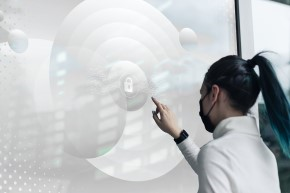With the global rise of eCommerce, there have been breaches in online transactions, causing retailers to be concerned about corporate security. Imposters have increased in number as product sales have increased. Having said that, there are tried-and-true techniques for dealing with impostor risks via identity verification. AI-powered
Identity Verification
is a critical tool for businesses and financial institutions since it may drastically limit cybercrime attack vectors.
Businesses dealing with large quantities of fund transfers entice criminal actors to consider various methods of breaking the transaction process through fraudulent strategies. When a consumer is a victim of fraud at an online store, it affects not just their bank accounts but also the company's reputation. That's why the AML name screening service is also important.
What is AI-powered Identity Verification?
AI-powered Identity Verification uses digital technology to authenticate that a person is who they claim they are. With the rise of e-services such as banking, government services, and healthcare, digital identity verification has become a popular method of gaining access to these platforms.
Know Your Customer (KYC) Checks
To begin with, KYC checks are a regular practice in most firms. The goal of these checks is to verify that they understand who their customers are, what type of action is expected from a specific consumer, and what type of danger they may provide to the firm. Such examinations are necessary to safeguard the business's long-term viability. This, however, is a time-consuming and exhausting process. An AI-powered Identity Verification, with the added benefit of machine learning algorithms, can detect any attempt at documenting fake information on an identity document much more quickly and efficiently than a non-AI system or a manual review process. Biometric features acquired during the facial verification procedure can be compared to the face image on an identity document. This establishes the final judgment, either in favor of or against the identity of the entering user.
AI And Biometric Authentication
KYC and KYB (Know Your Business) compliances are accomplished with biometric authentication. It verifies a person's identity via fingerprints, eyeball scanning, or facial scanning. It can also be used to authenticate employees on the job. Because of biometric authentication, conventional methods of authentication, such as passwords or PIN codes, have long been obsolete. Biometrics can create data-driven safety protocols with the help of AI, and the verification solution cannot be manipulated by fraudsters. Here are some examples of how AI can be used with biometric verification:
Facial Recognition
A photo or video of the owner can readily fool facial recognition systems. Many incidents where the system has been deceived have been caused by 2D facial recognition. This is where AI comes into play by utilizing 3D biometric facial recognition technology. It recognizes the person's face and learns from a variety of images. AI can also tell if someone is wearing a face mask, taking a picture of an image, taking a screenshot, or utilizing a modified document with a phony picture. As a result, AI combined with biometrics provides an ideal solution for bio authentication.
Voice Recognition
In these biometric systems, AI can be used to recognize voices. Voice patterns such as speed, tone, accent, and so on can also be analyzed. For biometric verifications, AI can evaluate a person's voice.
How Does AI-powered Identity Verification Fight Digital Fraud?
Impeding Fraud
When a customer wants to digitally onboard an organization, the system asks for personally identifying information (PII). For example, the client's full name, address, and birth date. It also employs 2FA and consent note verifications to keep users safe. Businesses can also use video-based KYC and age authentication systems to improve the quality of their services.
Thousands of AI models powering the authentication system process data in seconds to produce real-time verification results. If a hacker attempts to circumvent security measures in order to achieve their malicious goals, the techniques (for example, spoof attacks) will fail.
Reducing Money Laundering
An AML screening method is also included in the identity authentication system. It ensures that no client uses any business database without first doing a thorough data evaluation. The AI-powered Identity Verification also compares the client's profile to PEP lists. Such entities are frequently involved in money laundering instances. The verification procedure discovers them and assesses the risk they pose.
KYC encompasses a wide range of services. The integration of AI with identity verification services has enabled it to authenticate client papers in foreign languages. AI-powered Identity Verification easily accepts various template submissions from clients all over the world. As a result, fraudsters who seek to circumvent security measures by using stolen/fabricated papers are unsuccessful in their fraud attempts.
Minimising Credit Card Fraud
Identity identification procedures have become more complex and sophisticated than ever before, but so have hacker techniques as a result of technological breakthroughs. Financial institutions have used AI-powered Identity Verification to monitor Mastercard users' transactions for this reason.
It also tracks consumers' shopping habits by tracking their financial transaction history on a regular basis. It also collects information from retailers and card issuers in order to authenticate payments. As a result, some organizations use fingerprint scanning and online face recognition techniques to combat credit card fraud.
How Does the System Work?
Because of the digital revolution, AI-powered Identity Verification procedures have evolved. The entire procedure takes only a few seconds to finish. It's on the list below.
- Data Gathering: The first step is to enroll the user in the verification process. It begins by gathering personal information from customers. The app requests their name, date of birth, and address.
- Submission of Supporting Documents: The system then instructs the user to submit supporting evidence in the second stage. It is crucial in identity verification because it cross-checks all of the consumer's data. Users can only upload government-issued documents. ID cards, passports, debit cards, and utility bills, for example.
- Authentication of Final Information: Finally, the software determines the template of the records. Optical Character Recognition (OCR) technology extracts data from documents and stores it appropriately in the company's database. The AI-powered Identity Verification system's unique feature is that it also verifies the legitimacy of documents using various checks such as special ink and paper.
Creating A More Secure Digital Environment with IDV Solutions
The global pandemic caused a large and unexpected increase in all sorts of online engagement. As a result, the proportion of eCommerce expanded considerably. While traders devote their time to growing their enterprises, imposters focus their efforts on exploiting fresh opportunities for fraudulent activity. Through various identity verification approaches, digital providers require a clear image of who their customers are. AI-powered Identity Verification solutions clearly create a secure channel for completing online transactions. Identity Verification Services will ensure that electronic trading grows significantly now and in the future.
During the epidemic period, thousands of businesses became victims of digital identity theft. Verifying client identity is critical in putting a halt to the increasing number of fraud attempts. Fear of losing clients due to onboarding infractions, as well as the possibility of selling customers' identities to a third party, are compelling reasons to begin investing in AI-powered Identity Verification solutions. The demand for investing in AI-powered Identity Verification solutions to assure future sales and minimize identity theft and other online crimes is steadily increasing. In addition, AI-powered Identity Verification solutions validate consumer loyalty and experience.





